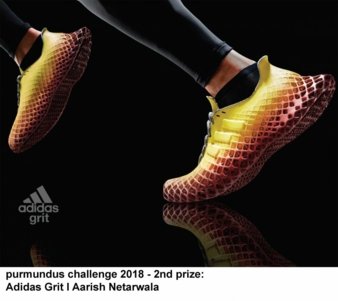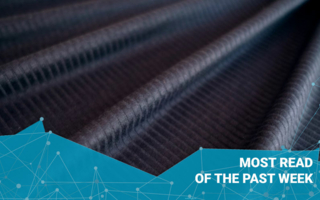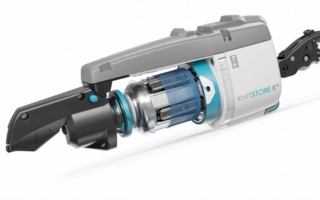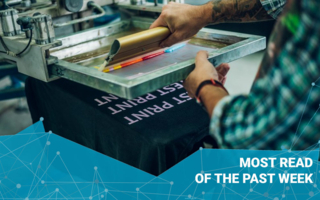04/12/2018 – Adidas Grit — auf Deutsch lesen
Products of the future in 3D printing
The purmundus challenge 3D printing design award was presented for the sixth time in Frankfurt. The 2nd prize won Adidas Grit

Aarish Netarwala, United States: “Adidas Grit is a pair of resistance training shoes, that replicates the experience of training on soft sand. Grits can be worn to by athletes to train on any running surface. The sole of the shoe mimics sand and absorbs energy from the user, fatiguing the leg muscles faster through strenuous exercise.” © Adidas
Grit is a pair of resistance training shoes, that replicates the experience of training on soft sand. In manufacturing and assembly, Grit contains just two main pieces. A fabric knit sock is slipped into a 3D printed EPU recyclable lattice sole.
Grits can be worn to by athletes to train on any running surface. The sole of the shoe mimics sand, it absorbs energy from the user, fatiguing the leg muscles faster through strenuous exercise. Studies have shown, through sand training, athletes build up leg strength over time and reduce post-workout muscle soreness. The shoes are to be used only in training sessions. Come game day, playing without Grits makes performing considerably easier for any athlete.
The concept of Grit is based on research conducted on sand dune resistance training
The world’s greatest athletes, Kobe Bryant, Kevin Durant and other elite athletes, train on soft sand to increase their level of difficulty of exercise. Sand training slows them down considerably, training explosive muscle movements and strengthening specific muscles for acceleration. The goal of running with Grit’s is to function and feel like running in soft sand. The foot is nested in a lattice sole. When the foot strikes the ground, the lattice collapses and dissipates the energy from impact. This experience feels extremely comfortable on the bones with the shoes absorbing a majority of the impact.
When the athlete transfers body weight to the front of the foot, the structure of the sole is designed to sink, countering the athlete‘s motion forward. When the foot has lifted off the ground, the lattice sole relapses to its original form, ready for the next step.
While exercising with Grits on any surface, the shoes aim is to increase the amount of energy required to train. This experience provides athletes with intense but effective training in a short period of time.
Grit designed by Aarish Netarwala is unique in 5 ways.
1. No shoe in the market today address the need and benefits of resistance training. Grit is the first of its kind, creating a new category of training shoes that cater to the physical needs of athletes today.
2. Grit makes training for athletes harder not easier, this is a new philosophy for footwear where traditionally designs cater to enabling the athlete as much as possible.
3. The construction of the shoe in Grit is unique as the bottom sole nests around the foot. This essentially surrounds the entire foot with a soft and supportive sole that absorbs impact at all angles like sand does.
4. In manufacturing and assembly, Grit contains just two main pieces. A fabric knit sock is slipped into a 3D printed EPU recyclable lattice sole. The two parts are knitted together. The materials are easily separated and recycled post use. Traditional soles are made from composite EVA foam with the strong glues and a manufacturing process that renders the shoes non-recyclable.
5. The visual aesthetic of Grit pushes the boundaries of what is possible with emerging materials and production techniques.
The purmundus challenge 3D printing design award
The purmundus challenge 3D printing design award was presented for the sixth time in Frankfurt as part of the Formnext exhibition. A total of six submissions received the coveted gold trophies.
34 finalists from around the world presented their outstanding designs on the theme of “3D printing gears up our future” from 13 to 16 November at the Formnext exhibition. They offered fascinating insights and ideas regarding how products could be designed in the future, and the role of 3D printing in this context.




